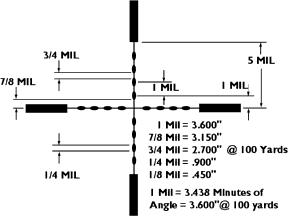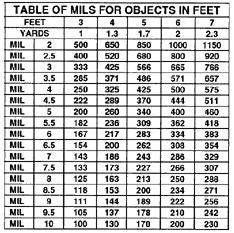Mil-Dot reticle
Some technical and historical information about the Mil-Dot reticle.
 |
This reticle was developed in the late 1970s to help U.S. Marine snipers estimate distances, and is now standard for all military branches. The space between dot centers subtends one milliradian(mil) hence the name mil-dot. Contrary to popular belief it does not stand for "military dot". One mil. subtends 3.6 inches at 100 yards or 36 inches at 1,000 yards. To use this system effectively you must know the size of the target. For instance most people are an average of 6 feet tall or 2 yards. The formula used for determining range to the target is (size of
target x 1000 divided by number of mils the target covers). Height of target (yards) X 1,000
= Range (yards) |
You can do these calculations with a calculator or use a reference
table like the ones listed below.
But remember that your answer is only as accurate as the numbers you plug
into the formula. An
error of just a 1/4 mil will cause an error in target range. Also an error
in estimating the size of your
target will cause an error in target range.
The top line on the table represents the size of the target
as measured in feet or inches. The second
line represents the conversion of the foot measurements to yards. The left
column shows the mil
measurements to the nearest 1/2mil. The mil scale can be split to the nearest
1/8mil. for a more
accurate range measurement. To use the table follow the instructions below.
|
Estimate height of target and locate across the top.
|
|
Measure height of target in mils and locate down the
side.
|
|
Move down from the top and right from the side to
find the range in yards.
|


Range Estimating with the Mil-Dot Reticle
Dots are spaced in one mil (milliradian) increments on the crosshair. Using
the mil formula, a table can be created like the ones above that is based
on
the size of the object being targeted. Just look through the scope, bracket
the object between dots, and refer to the table for an estimated distance
to target.
The radian is a unit less measure which is equivalent, in use, to degrees.
It tells you how far around a circle you have gone. 2 PI radians = 360 degrees.
Using 3.14 as the value of PI, 6.28 radians take you all the way around a
circle. Using a Cartesian coordinate system, you can use "x"- and
"y"-values
to define any point on the plane. Radians are used in a coordinate system
called "polar coordinates." A point on the plane is defined, in
the polar coordinate
system, using the radian and the radius. The radian defines the amount of
rotation and the radius gives the distance from the origin (in a negative
or positive
direction).
The radian is another measurement of rotation (the degree/minute/second-system
being the first). This is the system used in the mil-dot reticle. We
use the same equation that we used before, but, instead of your calculator
being in "degree" mode, switch it to "radian" mode. One
milliradian = 1/1000 (.001) radians. So, type .001 into your calculator and
hit the "tangent" button. Then multiply this by "distance to
the target." Finally, multiply this by 36 to
get inches subtended at the given distance. With the calculator in "radian"
mode, type:
tangent(.001)*100*36 = 3.6000012"
So, one milliradian is just over 3.6 inches at 100 yards. If we extrapolate, two milliradians equal about 6 feet at one-thousand yards.
The mil-dot reticle was designed around the measurement unit of the milliradian.
The dots, themselves, were designed with this in mind and the spacing
of the dots was also based upon the milliradian. This allows the shooter to
calculate the distance to an object of known height or width. Height of the
target
in yards divided by the height of the target in milliradians multiplied by
1000 equals the distance to the target in yards. For example, take a 6-foot-tall
man
(2 yards). Let's say that the top of his head lines up with one dot and his
feet line up four dots down. So: (2/4)*1000 = 500 yards away. This same technique
can be used to estimate lead on a moving target or to compensate for deflection
on a windy day.
The distance from the center of one dot to the center of the next dot is
1 milliradian. We are told (by Leupold) that the length of a dot on one of
their
reticles is 1/4 milliradian (Given this much information, one can determine
that the distance between dots is 3/4 milliradian.).* I use the term "length"
because
the mil-dot is not round in all cases. It is oblong in some scopes and round
in others (tasco). The width of each dot is an arbitrary distance and is not
used
for any practical purpose. Like a duplex reticle, the mil-dot reticle is thicker
towards the edges and uses thin lines in the middle where the dots are located
and the crosshairs cross. The distance between the opposite thick portions
is 10 milliradians on Leupold scopes.
*NOTE: 1/4 milliradian = .9" and 3/4 MOA = .785", so, obviously,
a mil-dot cannot be both 1/4 milliradian and 3/4 MOA. The maker of the mil-dot
reticles for Leupold explains: the dots on their mil-dot reticles are 1/4
mil. They are not 3/4 MOA. Apparently, Leupold just figured that more shooters
understand MOA than milliradians, so they just gave a figure (in MOA) that
was close, but not super precise.
To use a mil-dot reticle effectively, all one need remember is that the distance
between dot centers is 36" at 1000 yards. This lets you determine the
range of a target of known size. At that point, you can dial the scope in
for proper elevation OR use the dots to hold over the proper amount. The
dots on the horizontal crosshair can be used to lead a target (if you know
the range to the target, then you'll know the distance between dots, and thus
the distance to lead) or to compensate for deflection.
Minute-Of-Angle
The term "minute-of-angle" (MOA) is used regularly by target shooters
at the range, but is probably understood, thoroughly, by few (the same
goes for mil-dots). Defined loosely, one MOA = 1" @ 100 yards; so, if
you shot your rifle 5 times into a 100-yard target and every shot went into
a one-inch circle you had drawn on the paper, then your rifle could be said
to shoot 1 MOA. Likewise, if every shot goes into a two-inch circle at
200 yards, then you're shooting 1 MOA. A 10-inch group at 500 yards would
be 2 MOA.
Now for the fun part. There are 360 degrees in a circle. Each degree can
be broken down further into minutes. There are 60 minutes in a degree.
Likewise, there are 60 seconds in a minute. Now, to figure out the distance
subtended by 1 minute at any particular distance, we need merely to plug
those two values into a simple trigonometric equation. The tangent function
fits the bill nicely. Here's the equation:
tan(angle) = distance subtended/distance to the target (units must be consistent--e.g.,
1/36 of a yard [1"] divided by 100 yards)
Now, we know the angle (1 minute or 1/60 of a degree) and we know the distance
to the target (100 yards), but we need to figure out the actual distance
subtended at the target (i.e., is 1 MOA actually 1" @ 100 yards?). What
we need to do is solve for "distance subtended." Here's our final
equation:
tan(angle)*distance to the target = distance subtended
Make sure your calculator is in "degree" mode (as opposed to "radian"
or "gradian") and type in 1/60 (for degrees) and hit the "tangent"
button. Then
multiply that by 100 yards. This should give you the distance (in yards) subtended
at 100 yards. Multiply this by 36 to get inches. The answer should be:
1.047197580733"
This is just a hair over the commonly quoted "one inch." At 1000
yards, this would be almost 10 1/2 inches. Apparently, it is just a coincidence
that 1 MOA happens to be REALLY close to 1" @ 100 yards. It is, however,
quite convenient.